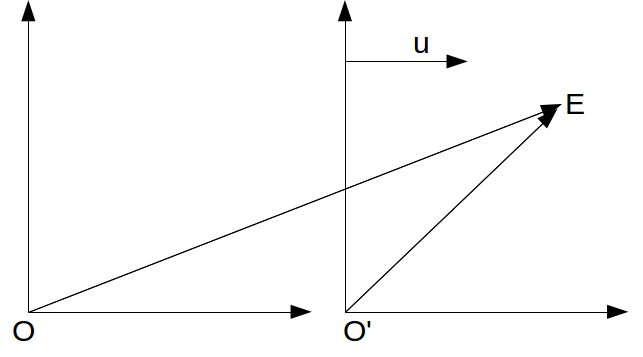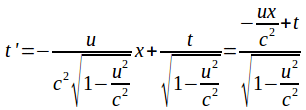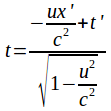A body of length![]() moving with speed
moving with speed![]() along the x – axis of an inertial frame O, but at rest in its own rest frame O' will be observed by a stationary observer to be apparently shortened to a length
along the x – axis of an inertial frame O, but at rest in its own rest frame O' will be observed by a stationary observer to be apparently shortened to a length and two events separated by a time interval of length
and two events separated by a time interval of length![]() in the rest frame O' will be observed by the stationary observer in rest frame O to be separated by a longer interval of time
in the rest frame O' will be observed by the stationary observer in rest frame O to be separated by a longer interval of time
Suppose the two inertial frames O and O' coincide at t=t'=0. At this instant a light pulse is emitted and produces an event E at coordinates![]() in the inertial frame O and
in the inertial frame O and![]() in the inertial frame O'.
in the inertial frame O'.

![]() and
and![]() are related by
are related by![]() Since O' is moving along the x axis of O,
Since O' is moving along the x axis of O,![]() and
and![]() hence
hence![]()
Since light travels in straight lines, the relationship between![]() and
and![]() will be linear so we can write
will be linear so we can write![]() (1) and
(1) and![]() (2)
(2)
Since![]() when light ray is emitted, from (1)
when light ray is emitted, from (1)![]()
(1) becomes![]() (3)
(3)
Substitute (2) and (3) these expressions into![]() to get
to get![]()
Equating coefficients of![]()
![]() (4)
(4)
Equating coefficients of![]()
 (5)
(5)
Equating coefficients of![]()
![]() (6)
(6)
Square (5) to give (7)
(7)
From (4) and from (6)
and from (6)
Substitute these into (7) to obtain
Expanding and simplifying gives
Then (Take the positive square root so that
(Take the positive square root so that![]() and
and![]() flow in the same direction).
flow in the same direction).
From (5)
Then and
and
The transformation is symmetrical, so and
and